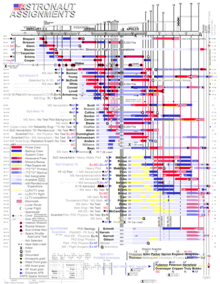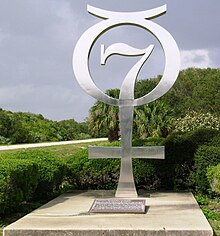Mercury Seven





Mercury Seven was the group of seven Mercury astronauts selected by NASA on April 9, 1959. They are also referred to as the Original Seven and Astronaut Group 1. This was the only astronaut group with members that flew on all classes of NASA manned orbital spacecraft of the 20th century: Mercury, Gemini, Apollo, and ending with John Glenn's flight on the STS-95 Space Shuttle mission.
The surviving members of the Mercury Seven are Glenn and Scott Carpenter.
Selection process
Although NASA planned an open competition for its first astronauts, President Dwight D. Eisenhower insisted that all candidates be test pilots, which excluded women.[2]: 13–14 Because of the small space inside the Mercury spacecraft, candidates could be no taller than 5 feet 11 inches (180 cm) and weigh no more than 180 pounds (82 kg).[3] Other requirements included an age under 40, a bachelor's degree or equivalent, 1,500 hours of flying time, and qualification to fly jets.[2]: 14
After an advertisement among military test pilots drew more than 500 applications, NASA searched military personnel records in January 1959 and identified 110 pilots—five Marines, 47 from the Navy, and 58 from the Air Force[4]—who qualified. Sixty-nine[5] candidates were brought to Washington, DC, in two groups; the candidates' interest was so great, despite the extensive physical and mental exams from January to March, that the agency did not summon the last group.[2]: 14–15 The tests included spending hours on treadmills and tilt tables, submerging their feet in ice water, three doses of castor oil, and five enemas.[5] Six candidates were rejected as too tall for the planned spacecraft. Another 33 failed or dropped out during the first phase of exams. Four more refused to take part in the second round of tests, which eliminated eight more candidates, leaving 18.[2]: 16
From the 18, the first seven NASA astronauts were chosen,[6] each a "superb physical specimen" with a genius-level IQ, and the ability to function well both as part of a team and solo.[5] Despite the extensive medical evaluation, two of the seven (Shepard and Slayton) were soon grounded for undiagnosed medical conditions and sat out the entirety of Project Gemini and most of the Apollo program (and Mercury as well, in Slayton's case) supervising the active astronauts.
Heroes
NASA introduced the astronauts in Washington on 9 April 1959. Although the agency viewed Project Mercury's purpose as an experiment to determine whether humans could survive space travel, the seven men immediately became national heroes compared to "Columbus, Magellan, Daniel Boone, Orville and Wilbur Wright."[5] 200[5] reporters overflowed the room used for the announcement and alarmed the astronauts, who were unused to such a large audience.[2]: 16–18
Because they wore civilian clothes, the audience did not see them as military test pilots but "mature, middle-class Americans, average in height and visage, family men all", ready for single combat versus worldwide Communism. To the astronauts' surprise, the reporters asked about their personal lives instead of war records or flight experience, or about the details of Mercury. After Glenn responded by speaking eloquently "on God, country, and family" the others followed his example,[2]: 18–19 and the reporters "lustily applauded them."[5]
The astronauts participated in Project Mercury's design and planning.[2]: 25–26 While busy with such duties and the intense training for their flights,[2]: 22 the men also "roughhoused and drank and drove fast and got into sexual peccadilloes", likely due to the dangerous nature of their work.[2]: 35 NASA actively sought to protect the astronauts and the agency from negative publicity and maintain an image of "clean-cut, all-American boy[s]".[2]: 20
Media
The seven astronauts agreed to share equally any proceeds from interviews regardless of who flew first.[5][7] In August 1959, they and their wives signed a contract with Life magazine for $500,000[7] in exchange for exclusive access to their private lives, homes, and families.[2]: 16 They wrote first-hand accounts of their selection and preparation for the Mercury missions in the 1962 book We Seven. Additionally, each of them separately wrote at least one book describing their astronaut experiences. In 1979, Tom Wolfe published a less sanitized version of their story in The Right Stuff. Wolfe's book was the basis for the popular film of the same name directed by Philip Kaufman.
Their official spokesman from 1959-1963 was USAF Lt. Col. John "Shorty" Powers, who as a result became known in the press as the "eighth astronaut".
In the 1960s TV series Thunderbirds, the Tracy brothers were given the forenames of five of the Mercury astronauts: Scott, Virgil, Alan, Gordon and John.
Group members


- Alan Bartlett Shepard Jr., USN, (1923–1998)
- Virgil Ivan (Gus) Grissom, USAF, (1926–1967)
- John Herschel Glenn Jr., USMC, (born 1921)
- Malcolm Scott Carpenter, USN, (born 1925)
- Walter Marty (Wally) Schirra Jr., USN, (1923–2007)
- Leroy Gordon Cooper Jr., USAF, (1927–2004)
- Donald Kent (Deke) Slayton, USAF, (1924–1993)
See also
References
- ^ Slayton, Donald K. (1994). Deke!. New York: Forge. p. 87. ISBN 0312-85918-X.
{{cite book}}: Unknown parameter|coauthors=ignored (|author=suggested) (help) - ^ a b c d e f g h i j k Logsdon, John M. with Roger D. Launius (editors) Exploring the Unknown: Selected Documents in the History of the U.S. Civil Space Program / Volume VII Human Spaceflight: Projects Mercury, Gemini, and Apollo The NASA History Series, 2008.
- ^ Slayton, Donald K. (1994). Moon Shot: The Inside Story of America's Race to the Moon. Turner Publishing. ISBN 1-57036-167-3.
{{cite book}}: Unknown parameter|coauthors=ignored (|author=suggested) (help) - ^ No Army pilot that had attended test pilot school and met other qualifications were found.
- ^ a b c d e f g "Rendezovus with Destiny" Time, 20 April 1959.
- ^ Carmichael, Mary (2007). "Actually, It Is Rocket Science: NASA's Brilliant, Far-Out History". Mental_Floss. 6 (6): 42.
{{cite journal}}:|access-date=requires|url=(help); Cite has empty unknown parameter:|coauthors=(help); Unknown parameter|month=ignored (help) - ^ a b "The Big Story" Time, 24 August 1959.

